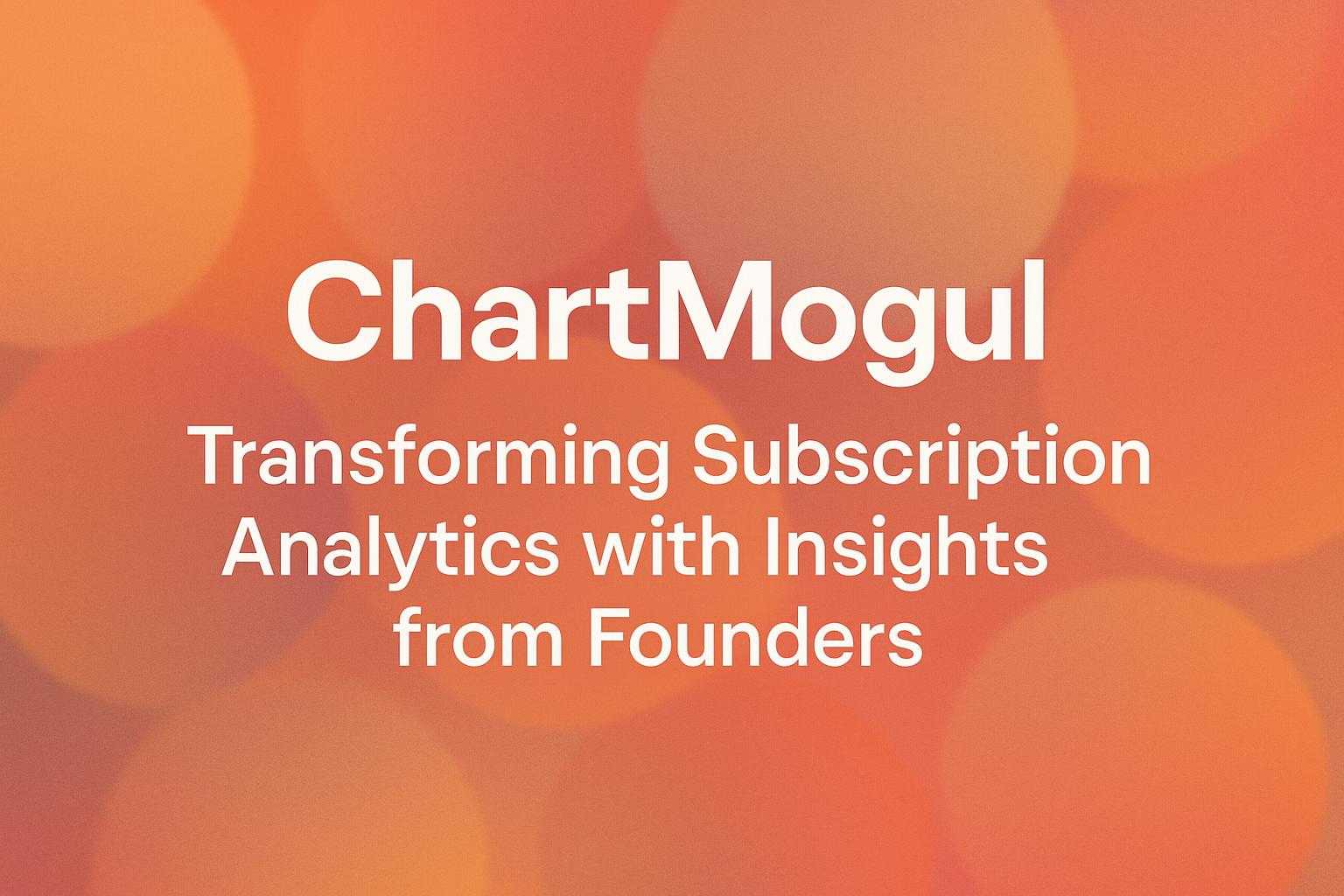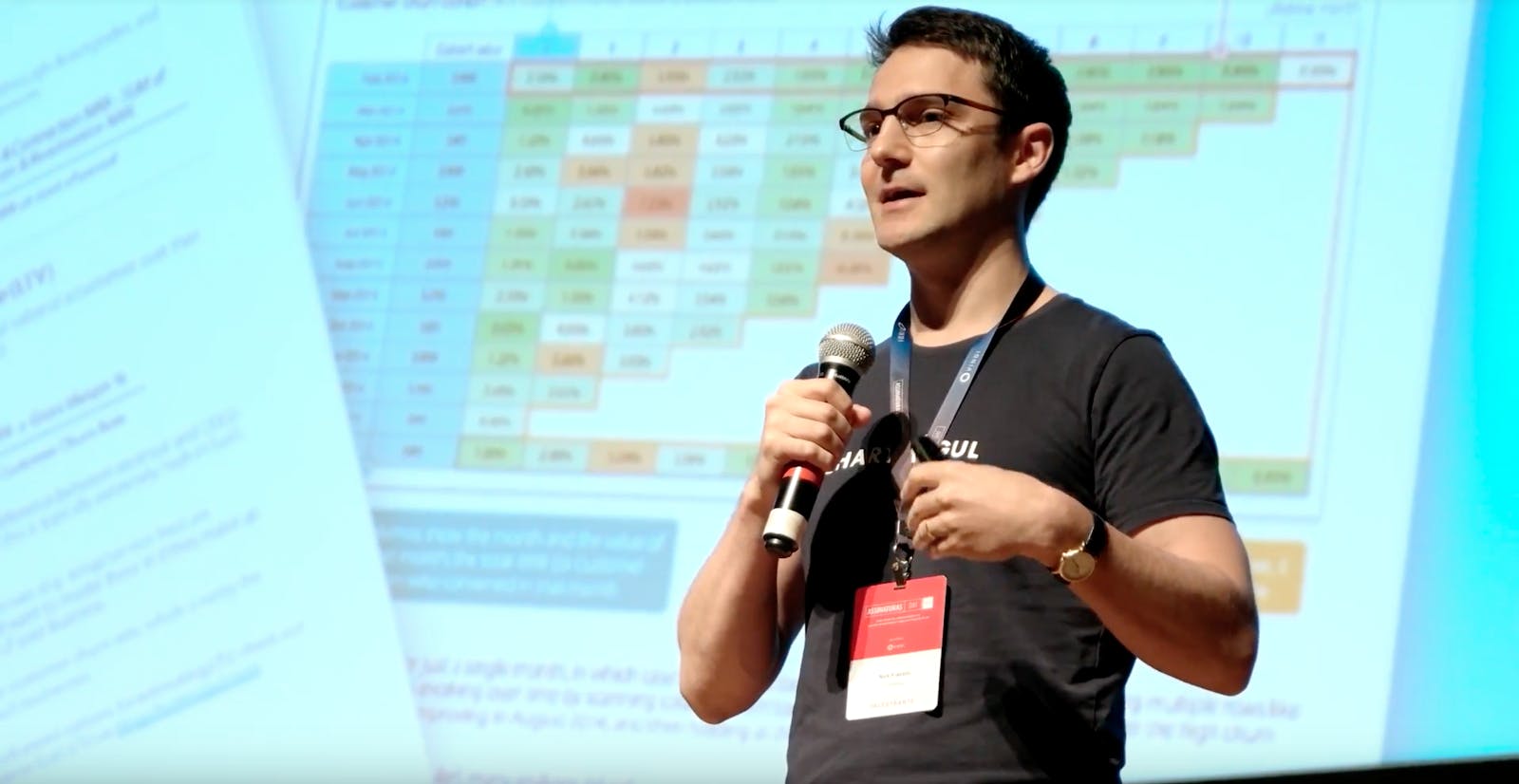ChartMogul: Transforming Subscription Analytics with Insights from Founders

Company profile
Company business details
Motivation to build the product
The founders were motivated by the challenges subscription businesses face in tracking and understanding their recurring revenue metrics. They recognized a gap in the market for a dedicated analytics solution that could simplify this process and provide actionable insights.Problem that their product solves
ChartMogul solves the problem of tracking and analyzing subscription metrics for businesses that rely on recurring revenue. The end users are subscription-based companies that need to understand their customer data and trends to optimize their revenue strategies and improve customer retention.Their unfair advantage
ChartMogul's unfair advantage lies in its ability to integrate seamlessly with various payment and billing systems, providing real-time analytics and insights that are tailored specifically for subscription businesses.Strategies
Pre-Launch (Product Development & MVP)
Beta Development and Initial Funding
Nick Franklin financed the initial beta development of ChartMogul using his savings, which amounted to between $50K and $100K. He hired 2-3 engineers through UpWork and collaborated with a creative director for design. This investment was crucial to build a robust product that could be launched in a timely manner, allowing them to enter the market with a competitive edge.
Custom Dashboard Development
Nick Franklin, the founder of ChartMogul, created a custom dashboard while working at Zendesk to track key subscription metrics like MRR and customer numbers. This dashboard was designed to provide real-time updates and insights, which were lacking in existing solutions. The addictive nature of checking this dashboard led him to realize the potential for a dedicated analytics solution tailored for subscription businesses.
Prototype Development with Contractors
Nick Franklin, the founder of ChartMogul, took a hands-on approach to product development by learning Ruby on Rails and JavaScript to build a prototype for his subscription analytics platform. He hired contractors to assist in the development process while also actively participating in building the product himself. This dual approach allowed him to create a functional MVP that could be tested and refined before the official launch.
Launch Stage
Initial Customer Acquisition through Networking
After securing seed funding from 0.9 Capital, Nick attended meetups in Berlin to build his network and find his first hires. At a Product Hunt meetup, he met his first hire, who is now the Director of Content. This strategy of leveraging local meetups helped him establish a team and gain traction in a new city.
Initial Customer Acquisition
After launching the early version of ChartMogul in late 2014, Nick focused on acquiring the first paying customers. By January 2015, they secured their first paying customer, which was a significant milestone for the company. This initial traction validated their product and provided the necessary momentum to continue building the business.
Product Hunt Launch
ChartMogul was officially launched at the first Product Hunt meetup in Berlin, which took place towards the end of 2014. This event led to them being featured on Product Hunt the following day, resulting in a significant influx of signups. This strategy not only provided immediate visibility but also helped establish early customer relationships, some of whom remain clients today.
Growth Stage
Content Marketing and Co-Marketing
To attract users and grow the company, ChartMogul engaged in content marketing by creating valuable content and syndicating it across various platforms. They also focused on co-marketing with integration partners like Stripe and PayPal/Braintree. This approach helped them build strong relationships and leverage the audiences of their partners, significantly enhancing their reach and brand awareness.
Building Strong Integration Partnerships
ChartMogul prioritized building strong relationships with integration partners such as Stripe, PayPal/Braintree, and Recurly. By collaborating with these partners, they not only enhanced their product offerings but also gained access to a wider customer base. This strategy was instrumental in establishing credibility and trust within the SaaS community.
Focus on Hiring and Team Building
Nick emphasized the importance of hiring the right team as the company grew. He recognized that once initial market validation was achieved, his primary role shifted to building a competent team. He actively sought to promote from within, ensuring that team members who showed leadership potential were given opportunities to advance.
Investing in Brand Awareness for Recruitment
As ChartMogul grew, Nick noted that brand awareness became crucial for attracting top engineering talent. The company built a strong product and brand presence, which made it easier to recruit engineers who were familiar with their work. This included showcasing their involvement with developer products that engineers used daily.
Customer Retention through Product Development
Nick focused on reducing churn by addressing product limitations identified through NPS surveys and exit interviews. He recognized that over 50% of cancellations were due to product issues rather than pricing or dissatisfaction. By prioritizing product development to fix these issues, he aimed to improve customer retention and enhance word-of-mouth referrals.
Content Marketing for Lead Generation
Nick leveraged content marketing as a significant source of leads, creating valuable resources like the 'SaaS Metrics Cheat Sheet' that resonated with the audience. He analyzed past successful content to identify trends and aimed to produce timely, relevant pieces that aligned with emerging conversations in the industry.
Venture Capital Funding
To fuel the growth of ChartMogul, Nick successfully raised venture capital funding from notable investors, including his former boss from Zendesk. This seed money was crucial in scaling the operations and enhancing the product offerings, allowing the company to invest in engineering and marketing efforts to attract more customers.
Focus on Product and Customer Satisfaction
Throughout the growth stage, Nick emphasized the importance of continuously improving the product and ensuring customer satisfaction. He believed that the core of a successful SaaS business lies in building a great product and having happy customers. This focus on product quality and customer experience helped ChartMogul to retain customers and grow its user base.
Freemium Pricing Model
Chart Mogul implemented a freemium pricing model that allowed users with less than $10,000 in monthly recurring revenue (MRR) to access the platform for free. This strategy aimed to attract bootstrapped startups and smaller businesses, providing them with valuable analytics tools without any initial cost. As these businesses grew and surpassed the $10,000 MRR threshold, they would transition to a paid plan, thus creating a natural conversion path from free to paid users.
Data-Driven Insights
Chart Mogul focused on providing data-driven insights to its users by automating the reporting of key subscription metrics such as churn rate and lifetime value. This feature not only saved users time but also helped them make informed decisions about pricing and customer retention strategies. By emphasizing the importance of these insights, Chart Mogul positioned itself as an essential tool for subscription businesses looking to optimize their growth.
Maturity & Scaling
Brand Development and Rebranding
As part of their growth strategy, ChartMogul invested in building their brand and underwent a rebranding process. This included updating their visual identity and messaging to better resonate with their target audience. The rebranding effort was aimed at solidifying their market position and enhancing customer recognition, which is crucial for long-term success.
Regular Team Alignment Meetings
To maintain focus and alignment within the remote team, Nick implemented regular one-on-ones with direct reports and quarterly All Hands meetings. This structure ensured that everyone was aware of departmental updates and company goals, fostering a cohesive work environment despite geographical distances.
Utilizing Customer Feedback for Product Improvement
Nick utilized Typeform to collect NPS scores and feedback from customers, which were then shared across the company. This practice allowed all teams to understand customer needs and pain points, guiding product development and enhancing overall service quality.
Introduction of CRM for B2B SaaS
In a strategic move to expand their product offerings, ChartMogul launched a CRM specifically tailored for B2B SaaS companies. This new product integrates subscription analytics, providing a unique solution for mid-market B2B SaaS businesses. By leveraging their existing customer base and expertise in subscription analytics, Nick aimed to capture a larger market share and enhance the value provided to their customers.
Celebrating Milestones and Team Building
Nick recognized the importance of celebrating key milestones, such as the company's 10-year anniversary. He organized a team event in Croatia, bringing together nearly all employees to foster team spirit and acknowledge their collective achievements. This focus on team culture and recognition helps maintain morale and encourages continued dedication to the company's goals.
Simplified Pricing Structure
After experimenting with various pricing models, ChartMogul settled on a revenue-based pricing structure that charges users 0.25% of their MRR, starting with a base fee of $100. This model simplified the sales process by eliminating discounts and aligning the company's success with that of its customers. As users' revenues grew, so did ChartMogul's revenue, creating a mutually beneficial relationship that facilitated smoother operations and customer satisfaction.
Saturation & Retention
Focus on Reducing Churn
Recognizing the importance of customer retention, ChartMogul shifted their focus towards reducing churn rates. They implemented strategies to understand and address the reasons behind customer cancellations, which included refining their product and improving customer support. This proactive approach to retention was seen as a critical factor in sustaining revenue growth as they scaled.
Learn more about ChartMogul

Founder Interviews: Nick Franklin of ChartMogul

Interview: Nick Franklin, CEO & Founder of ChartMogul, on hiring, scaling, and work/life balance

STOP thinking about Scaling! Nick Franklin on How to Scale



